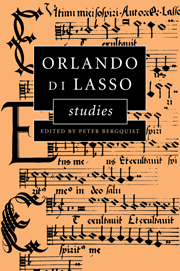Book contents
- Frontmatter
- Contents
- Preface
- List of abbreviations
- 1 Aspects of form in Orlando di Lasso's Magnificat settings
- 2 Orlando di Lasso and Andrea Gabrieli: two motets and their masses in a Munich choir book from 1564–65
- 3 Post-Tridentine liturgical change and functional music: Lasso's cycle of polyphonic Latin hymns
- 4 The salon as marketplace in the 1550s: patrons and collectors of Lasso's secular music
- 5 Lasso's “Standomi un giorno” and the canzone in the mid-sixteenth century
- 6 Lasso's “Fertur in conviviis”: on the history of its text and transmission
- 7 Orlando di Lasso and Rome: personal contacts and musical influences
- 8 Orlando di Lasso as a model for composition as seen in the three-voice motets of Jean de Castro
- 9 The madrigal book of Jean Turnhout (1589) and its relationship to Lasso
- 10 Modal ordering within Orlando di Lasso's publications
- 11 Correct and incorrect accentuation in Lasso's music: on the implied dependence on the text in classical vocal polyphony
- General index
- Index of Lasso compositions and printed sources
7 - Orlando di Lasso and Rome: personal contacts and musical influences
Published online by Cambridge University Press: 18 December 2009
- Frontmatter
- Contents
- Preface
- List of abbreviations
- 1 Aspects of form in Orlando di Lasso's Magnificat settings
- 2 Orlando di Lasso and Andrea Gabrieli: two motets and their masses in a Munich choir book from 1564–65
- 3 Post-Tridentine liturgical change and functional music: Lasso's cycle of polyphonic Latin hymns
- 4 The salon as marketplace in the 1550s: patrons and collectors of Lasso's secular music
- 5 Lasso's “Standomi un giorno” and the canzone in the mid-sixteenth century
- 6 Lasso's “Fertur in conviviis”: on the history of its text and transmission
- 7 Orlando di Lasso and Rome: personal contacts and musical influences
- 8 Orlando di Lasso as a model for composition as seen in the three-voice motets of Jean de Castro
- 9 The madrigal book of Jean Turnhout (1589) and its relationship to Lasso
- 10 Modal ordering within Orlando di Lasso's publications
- 11 Correct and incorrect accentuation in Lasso's music: on the implied dependence on the text in classical vocal polyphony
- General index
- Index of Lasso compositions and printed sources
Summary
The common use of the Italian version of his name serves to underline the important part played by Italy and Italian music in the life and work of Orlando di Lasso. His earliest adult musical experiences took place there in the 1550s and he paid frequent visits thereafter; he composed madrigals and villanelle to Italian texts and his music attained considerable popularity in Italy. This essay examines Lasso's relations with one important Italian center, Rome. Personal and musical contacts between the composer and the city occurred during three main periods: the early 1550s when, as a young man, he lived and worked there; the early 1560s when his compositions played a major part in an exchange of music between Rome and Munich; and the year 1574 when he revisited the papal city while on a tour of Italy looking for singers. The 1550s and 1574 provided opportunities for personal contacts with Roman musicians; as well as the 1560s exchange, evidence of musical contact also comes from Roman manuscripts and from contemporary inventories of music held at the city's institutions.
Of particular interest is the possibility of musical cross-fertilization between Lasso and Palestrina, the two major musical figures in their respective cities, who also coincidentally died in the same year. While there is no direct evidence of personal contact between them, these two composers must surely have known each other when they simultaneously held positions as maestri di cappella at Rome's two most important basilicas during the early 1550s.
- Type
- Chapter
- Information
- Orlando di Lasso Studies , pp. 132 - 157Publisher: Cambridge University PressPrint publication year: 1999

